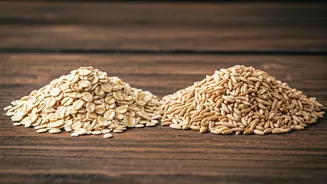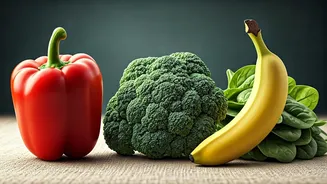The Organic Promise
The term 'organic' is frequently displayed on food packaging, often evoking images of healthy eating, environmental stewardship, and ethical farming practices.
However, the label's true meaning can often be obscured by vague marketing. Understanding what 'organic' truly means is the first step toward making informed food choices. It ensures that the products you are buying align with your values. Authentic organic products adhere to specific standards regarding how food is produced, processed, and handled. These standards usually involve the avoidance of synthetic pesticides, herbicides, and fertilizers. They also often involve adherence to practices that preserve soil health and biodiversity. Becoming an informed consumer allows individuals to support farmers and companies committed to these practices. This promotes healthier food systems and protects the environment.
Labeling Essentials Uncovered
Navigating the world of organic labels requires a keen eye. Look beyond the appealing graphics and promotional claims. The United States Department of Agriculture (USDA) certification is a trusted indicator of adherence to the country’s organic standards. Foods bearing the USDA organic seal meet rigorous requirements. They must be produced without prohibited substances, such as synthetic pesticides and fertilizers. Products can be labeled '100% organic,' 'organic,' or 'made with organic ingredients,' each with different criteria. '100% organic' means all ingredients are organic. 'Organic' means at least 95% of ingredients are organic. Products 'made with organic ingredients' contain at least 70% organic ingredients. Understanding these distinctions lets you make purchasing decisions that align with your needs and preferences. Checking the ingredient list is equally important to verifying that it matches the label’s organic claim. Be mindful of the ingredients used and their origins to get the real value.
Spotting Authentic Certifications
Authenticity in organic labeling is paramount. The presence of the USDA organic seal is a reliable indicator that the product adheres to specific standards. This seal provides assurance that the food has undergone thorough inspection and verification processes. However, relying solely on this seal is insufficient. Research the certifying agency to ensure its credibility. Verify if it's accredited by the USDA. Different countries and regions may have their own organic certifications. Familiarize yourself with these, especially if you purchase products imported from other places. For example, the European Union (EU) has its own organic logo. Look for logos and certifications that are specific to your location. These symbols offer consumers added confidence in the authenticity of the product. Be critical of marketing claims such as 'natural' or 'eco-friendly.' They are not regulated. They also do not necessarily denote the same standards as the organic label.
Decoding Tricky Terminology
Marketing language can often be misleading, so it is important to be vigilant when examining labels. Terms such as 'natural,' 'all-natural,' or 'made with organic ingredients' can appear appealing. However, they lack the same stringent standards as the official organic label. 'Natural' foods do not have the same level of regulation. This means they might contain ingredients that do not align with organic principles. Be wary of terms like 'pesticide-free' because it doesn't guarantee the product is organic. It only refers to a specific aspect of the farming process. Similarly, the claim 'no artificial flavors or colors' does not mean a product meets organic standards. This type of language may try to make the product sound healthy. Always prioritize products with the USDA organic seal or equivalent certification from a trusted agency. This helps you avoid being misled by clever marketing that exploits the consumer's perception of healthy food.
Prioritizing Whole, Real Foods
Beyond label reading, focusing on whole, unprocessed foods is a sound approach to a healthier diet. Fresh produce, minimally processed grains, and unprocessed meats are good choices. These foods typically have fewer ingredients and are free from additives and preservatives often found in packaged foods. When purchasing packaged goods, opt for options with a short and easily understandable ingredient list. Fewer ingredients typically mean fewer chances for hidden additives or synthetic compounds. Preparing meals at home provides better control over ingredients. It allows you to select fresh, organic ingredients. This is a very beneficial practice when starting a new organic lifestyle. Additionally, it helps you understand the source of the foods you consume. Eating locally and seasonally, if accessible, can also support organic farmers. This minimizes your carbon footprint. It also allows you to enjoy food at its peak flavor and nutritional value. Whole, real foods naturally align with organic principles. They promote overall health and well-being.
The Impact on Health
Choosing organic foods can offer several potential health benefits. Organic farming practices tend to avoid synthetic pesticides and herbicides. This might lead to lower exposure to harmful chemicals. Studies have suggested that organic foods may contain higher levels of certain nutrients, like antioxidants. Antioxidants are beneficial compounds that combat damage caused by free radicals in the body. Choosing organic produce can reduce the exposure to antibiotic-resistant bacteria, since organic farming prohibits the routine use of antibiotics. This is especially relevant to meat and poultry products. It’s also crucial to consider the impact on one's personal health needs. If you have sensitivities or allergies, organic products might minimize reactions because they are less likely to contain synthetic additives. Regular consumption of organic foods can boost immunity and assist with proper body function. It's important to remember that organic food is not a panacea. A balanced diet and overall healthy lifestyle is what matters. Always consult a healthcare professional for dietary advice tailored to your specific needs.
Supporting Sustainable Practices
Buying organic food supports farming practices that benefit the environment and human health. Organic farming focuses on soil health, biodiversity, and conservation. This often reduces the environmental impact of food production. Organic farms typically avoid synthetic fertilizers and pesticides. This minimizes pollution of water sources. Organic agriculture can also help to increase soil's carbon sequestration, reducing greenhouse gas emissions. Organic farming practices promote biodiversity by supporting a wider range of plant and animal species. This leads to more robust and resilient ecosystems. Consumers make a difference by choosing organic food. Their purchasing decisions support farmers committed to sustainable practices. They also encourage agricultural systems that prioritize environmental sustainability and ethical production. It's a way of promoting a food system that is good for people and the planet. Considering your impact, one can make choices that actively shape the world.
Making Informed Choices
Becoming a savvy consumer involves more than just reading labels. It means researching brands and understanding their commitment to organic practices. Visit the company’s website or contact customer service to understand their approach. Prioritize products from farmers who align with your values. Choose organic products certified by reputable agencies. Educate yourself on the various certifications and what they entail. Consider buying directly from local organic farmers. This provides the opportunity to know the source of your food. Visiting farmers markets, joining a Community Supported Agriculture (CSA) program, or visiting local farms can provide you with opportunities to connect with farmers. Be prepared to compare prices. Organic food often comes at a higher cost. However, consider it an investment in your health and the environment. Set a budget and prioritize organic products based on your nutritional needs. Choose foods where pesticide residues tend to be higher (e.g., leafy greens). This lets you maximize the benefits within your financial plan. By cultivating these practices, you transform from a shopper into a well-informed consumer.













